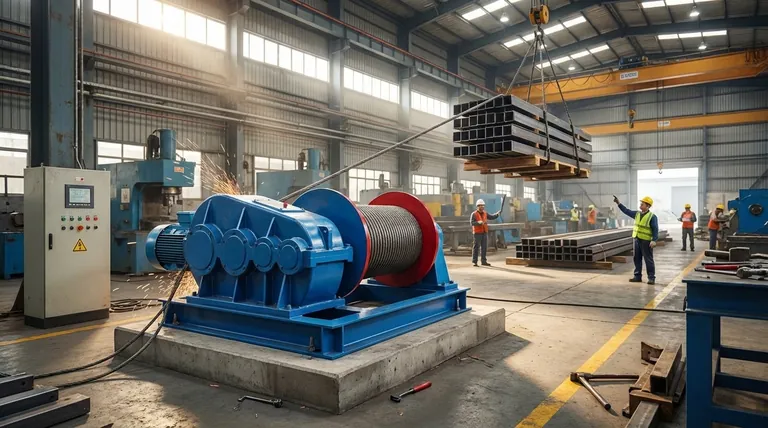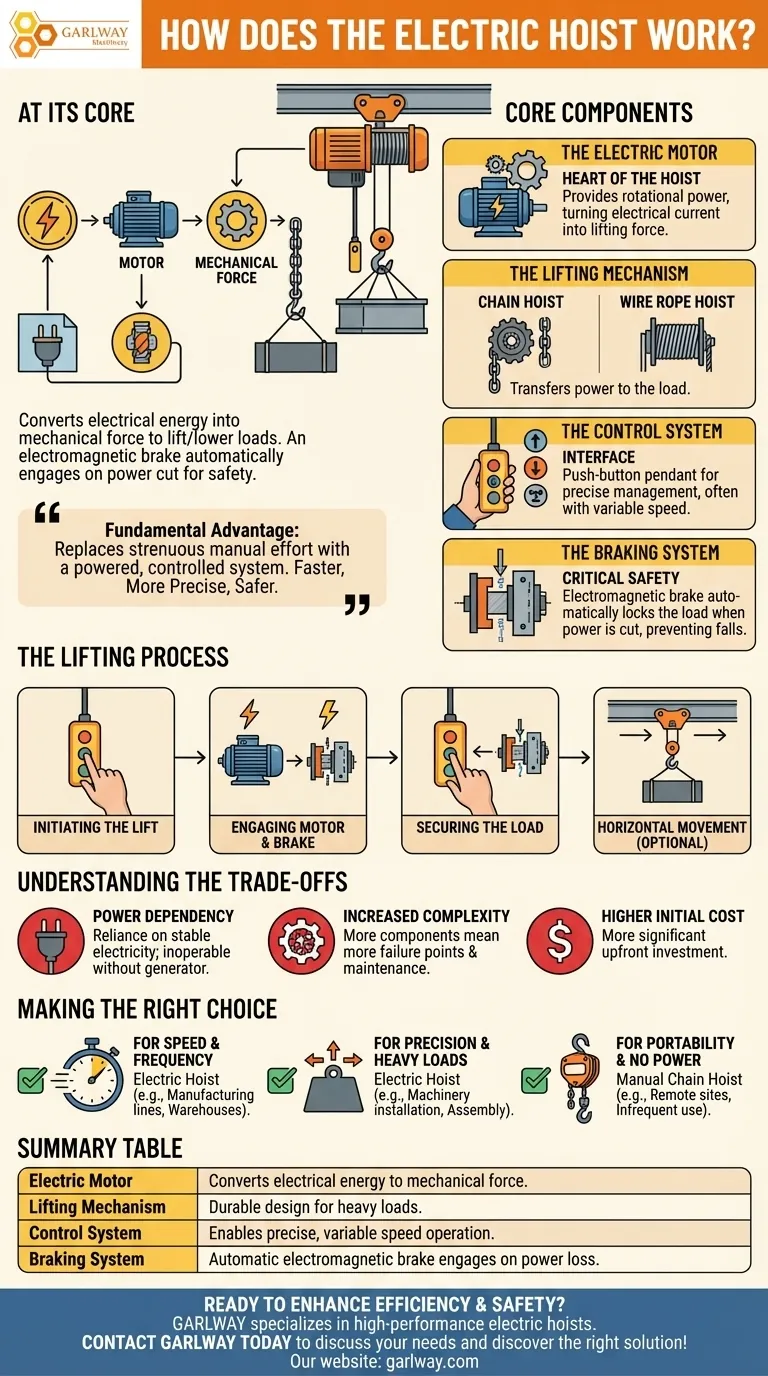At its core, an electric hoist works by using an electric motor to lift and lower heavy loads. It converts electrical energy into mechanical force through a system that includes a motor, a lifting medium like a chain or wire rope, and a control system. A critical safety feature, an electromagnetic brake, automatically engages to hold the load securely whenever power is cut or the operation is paused.
The fundamental advantage of an electric hoist is its ability to replace strenuous manual effort with a powered, controlled system. This makes lifting operations significantly faster, more precise, and safer than manual alternatives.

The Core Components of an Electric Hoist
To understand how an electric hoist functions, you must first understand its primary components. Each part plays a distinct and critical role in the lifting process.
The Electric Motor
The motor is the heart of the hoist. It provides the rotational power necessary to drive the lifting mechanism. This is the component that does the heavy work, turning electrical current into the force required to lift loads that would be impossible to move manually.
The Lifting Mechanism
This is how the motor's power is transferred to the load. Hoists typically use one of two main types:
- Chain Hoist: Uses a durable, load-bearing chain that runs through a sprocket driven by the motor.
- Wire Rope Hoist: Employs a steel wire rope that winds onto a grooved drum. This is often used for higher capacities and smoother lifting.
The Control System
The control system is the interface between the operator and the hoist. It typically consists of a push-button pendant that allows the operator to precisely manage the hoist's functions, such as lifting, lowering, and, in some cases, horizontal movement via a trolley. Modern systems often include variable speed control for delicate positioning.
The Braking System
This is arguably the most critical safety component. Electric hoists use an electromagnetic brake. When the motor is powered on to lift or lower, the brake is electromagnetically disengaged. The moment power is cut—either intentionally by the operator or due to a power failure—the brake automatically engages, locking the load in place and preventing it from falling.
The Lifting Process from Start to Finish
The operation of an electric hoist is a seamless integration of its core components, designed for both power and safety.
Initiating the Lift
The process begins when an operator presses a button on the control pendant. This sends an electrical signal to the hoist's motor and its braking system.
Engaging the Motor and Brake
The signal simultaneously energizes the motor to begin turning and disengages the electromagnetic brake. The motor's power is transferred through a gearbox to the chain sprocket or wire rope drum, which begins to lift the load.
Securing the Load
When the operator releases the button, power to the motor is cut. Instantly, the electromagnetic brake re-engages, preventing any further movement and holding the load securely at its current height.
Horizontal Movement
Many electric hoists are mounted on a trolley that runs along a beam or crane. A separate motor, also controlled by the pendant, powers this trolley, allowing the operator to move the suspended load horizontally across a work area.
Understanding the Trade-offs
While powerful and efficient, electric hoists are not the solution for every scenario. Understanding their limitations is key to making an informed decision.
Power Dependency
The most obvious limitation is their reliance on a stable source of electricity. In remote job sites or during power outages, they are inoperable without a generator.
Increased Complexity
Compared to a simple manual hoist, an electric hoist has far more components: motors, wiring, control circuits, and brakes. This complexity means there are more potential points of failure and a greater need for regular, skilled maintenance.
Higher Initial Cost
The motor, controls, and integrated safety systems make electric hoists a more significant upfront investment than their manual counterparts.
Making the Right Choice for Your Application
Selecting the correct type of hoist depends entirely on the demands of your work environment and the nature of the tasks you need to perform.
- If your primary focus is speed and frequent use: An electric hoist is the definitive choice for high-volume environments like manufacturing lines or busy warehouses.
- If your primary focus is precision and heavy loads: The variable speed controls and high capacity of an electric hoist are essential for delicate tasks like installing machinery or assembling large structures.
- If your primary focus is portability and use in areas without power: A manual chain hoist remains a reliable and cost-effective solution for infrequent lifting or remote job sites.
By understanding these core principles, you can select the right tool that prioritizes safety, efficiency, and control for your specific lifting needs.
Summary Table:
| Component | Function | Key Feature |
|---|---|---|
| Electric Motor | Provides rotational power for lifting | Converts electrical energy to mechanical force |
| Lifting Mechanism | Transfers power to the load (chain or wire rope) | Durable design for heavy loads |
| Control System | Interface for operator (pendant control) | Enables precise, variable speed operation |
| Braking System | Safety mechanism to hold the load | Automatic electromagnetic brake engages on power loss |
Ready to enhance your project's efficiency and safety?
GARLWAY specializes in high-performance construction machinery, including robust electric hoists designed for demanding environments. Our equipment helps construction companies and contractors globally lift heavier loads with greater precision and control, saving time and reducing manual labor risks.
Contact GARLWAY today to discuss your specific lifting needs and discover the right hoist solution for your business!
Visual Guide

Related Products
- Electric Hoist Winch Boat Anchor Windlass for Marine Applications
- Heavy Duty Electric Boat Winch Windlass Anchor
- Electric and Hydraulic Winch for Heavy Duty Applications
- Commercial Construction Mixer Machine for Soil Cement Mixing Concrete
- Ready Mixer Machine for Construction Ready Mix Machinery
People Also Ask
- What adjustments are necessary for the hoist winch's main controller? Achieve Sub-1 cm Lifting Precision
- What are the key precautions to follow when using an electric hoist? Ensure Safe and Efficient Lifting Operations
- What are the advantages of an electrically operated trailer winch? Enhance Safety & Control for Your Trailer
- What are the key steps for installing a hoist winch? Ensure Safety & Reliability for Your Project
- How should the hoist winch be debugged after installation? A 3-Phase Guide to Ensure Safety & Reliability






